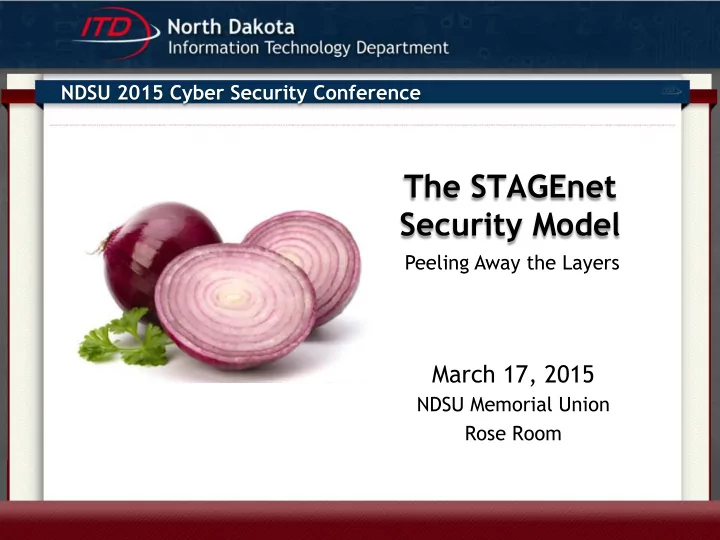

NDSU 2015 Cyber Security Conference The STAGEnet Security Model Peeling Away the Layers March 17, 2015 NDSU Memorial Union Rose Room
NDSU 2015 Cyber Security Conference Art Bakke Enterprise Information Security Administrator / Security Architect
Goal • To describe how security is strategically developed and implemented for STAGEnet enterprise network based on the needs of the various stakeholders.
Agenda • The Crown Jewels • Roles and Responsibilities • STAGEnet • Cybersecurity Framework
The Crown Jewels To Grave From Cradle And Beyond!
ITD’s Roles and Responsibilities • Per NDCC 54-59-05.2 and 54-59-05.14 ITD has the authority and responsibility for information systems security surrounding State of North Dakota information technology assets. • ITD is responsible for protecting the availability, integrity, and confidentiality of the state’s information systems and the data stored in information systems that are managed by ITD. • ITD also directs the development of standards, policies and guidelines for enterprise security. This is done in collaboration with state agencies through the Enterprise Architecture process. • Centralized Model
ITD Security Administrator Roles and Responsibilities • Lead enterprise information security team; manage and provide oversight for information security projects and programs • Develop security direction for ITD, State of North Dakota, political subdivisions & K-12 schools • Provide guidance to meet technical & legal requirements for access to 1,700+ servers, 10,000+ endpoints for 100,000+ users
What is STAGEnet? STAGEnet • The North Dakota Statewide Technology Access for Government and Education network (STAGEnet) provides broadband connectivity, Internet access, video conferencing and other networking services to all state agencies, colleges and universities, local government, and K-12.
What is STAGEnet? (continued) • STAGEnet is governed as a partnership between government and education that consists of three committees*, which aid in planning, prioritizing, approving standards, policies and procedures. Because of the varied nature and the variety of resources that use this network, security for it is built based on layers much like those of an onion. • *Executive Committee (State CIO, NDUS CIO, K12 Director, ITD Network Services Director) • *Management Committee (State, NDUS, ITD, IVN) • *Technical Committee (State, NDUS, ITD, K12)
Cybersecurity Framework
Cybersecurity Framework
Cybersecurity Framework • Security Framework Roles and Responsibilities • ITD Executive and Information Security Management • CIO/Deputy CIO Responsibilities • Enterprise Security Administrator • ITD Virtual Security Team • Information/Application Owners • Agency Directors • Agency IT Coordinators • Agency Security Officers
Cybersecurity Framework • Security Framework Roles and Responsibilities • Technology Providers • ITD Architects • Project Managers • Developers • Network and System Administrators • Supporting Functions • Audit, Physical Security, Contingency Planning • Quality Assurance, Training, Procurement • Human Resources, Facilities • Users of Information and Systems
Cybersecurity Framework Core Security Areas • Network Security • Host Security • Application Security • User Security •
Cybersecurity Framework
Cybersecurity Functions – The basis for our Framework Identify Detect Protect Respond Recover
Cybersecurity Functions – The basis for our Framework • Identify – What do I need to protect? • Protect – What controls do I use? • Detect – How do I know I am being attacked? • Respond – What actions do I take? • Recover – How do I return to normal operations? • Effective security encompasses the relationship between all five functions – it is a process, not a product.
Cybersecurity Principles • Security by Design • Defense in Depth • Compartmentalize • Utilize Control Points (Choke) Points • Fail Securely • Secure the Weakest Link
What Do I Need to Protect? Security Frameworks • Identify Audits/Risk Assessments • • Data Classification
What controls do I use? Encryption • Advanced Firewalls & Virtual Private Networks (VPN) • • Intrusion Prevention Systems (IPS) Protect Physical Security • Awareness & • Training • Identity & Access Management
How do I know I am being attacked? • Intrusion Detection Systems Detect (IDS) • Vulnerability Scanning • Audit Logs – Security Information and Event Management (SIEM) Systems
What actions do I take? Security Incident Response Team and processes • Cybersecurity Forensics • Proactive Vulnerability Management • Respond
How do I return to normal operations? Contingency Planning • Data Backups and High Availability Systems • Secondary Data Centers • Recover
Conclusion • The Crown Jewels • Roles and Responsibilities • STAGEnet • Cybersecurity Framework
Cybersecurity Functions – The basis for our Framework Identify Detect Protect Respond Recover Questions?
Thank you! Art Bakke Enterprise Information Security Administrator / Security Architect State of North Dakota ambakke@nd.gov
Recommend
More recommend